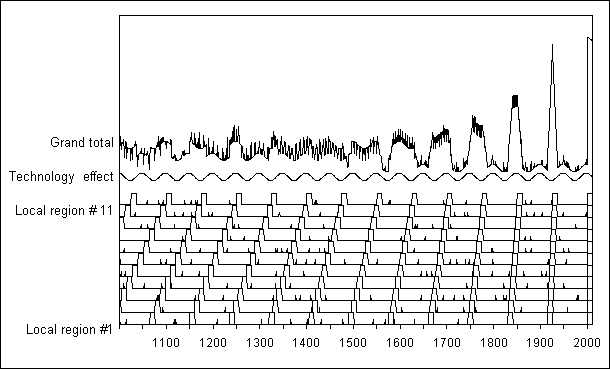Missionary (0.74/yr)
Swami Vivekanda (b 1863) - Ramkrishna Vendata Society
Eudorus Bell (b 1866) - Assembly of God
(b 1866) - Thomas Tsugi flourished
Georgii Gudshiev (b 1870) - Gurdjieff
Makiguchi (b 1871) - Soka Gakkai
Wallace Dodd Fahd (b 1871) - Nation of Islam
Sri Aurobindo (b 1872) - Integral Yoga
(b 1873) - Therese of Lisieux flourished
Charles Parham (b 1873) - Pentacostalism
William Saddler (b 1875) - Urantia
Edgar Cayce (b 1877) - Association of Research & Enlightenment
Frank Buchman (b 1878) - Moral Re-Armament
Guy Ballard (b 1878) - I AM
Ngo Minh Chieu (b 1878) - Cao Daism
Rev Jealous Devine (b 1880) - Int'l Peace Movement
Joeseph Moscati (b 1880) - Saint/Beatified
George Hensley (b 1880) - Snake Handlers
Lost (1.22/year)
Eberhard Arnold (b 1883) - Bruderhof
H Spencer Lewis (b 1883) - Rosicrucians (AMORC)
Phineas Breeze (b 1883) - Church of Nazarene
Gerald Gardner (b 1884) - Wicca
Victor Tasho Houteff (b 1885) - Branch Davidians
Ernest Holmes (b 1887) - Religious Science
Padre Pio (b 1887) - Saint/Beatified
Isidore Bakunja (b 1887) - Saint/Beatified
Marcus Garvey (b 1887) - Universal Negro Improvement Assoc
(b 1888) - Jose Maria Robles Hurtado flourished
Howard Rand (b 1889) - Christian Identity
Armee Semple McPherson (b 1890) - Foursquare Gospel
Kyososama (b 1891) - Shinreikyo
Theresa Benedicta of the Cross (b 1891) - Saint/Beatified
Herbert Armstrong (b 1892) - Worldwide Church of God
Paramahausa Yogananda (b 1893) - Self-Realization
Merwan Irani (b 1894) - Meher Baba
Maximilian Kolbe (b 1894) - Apparition of Mary in Poland
Mamillian Kolbe (b 1894) - Apparition of Mary in Poland
Cornelius Van Til (b 1895) - Christain Reconstructionist
William Wilson (b 1895) - Alcoholics Anomonous
Swami Prabhupada (b 1896) - Hare Krishna
GI (1.04/year)
Okada Kotama (b 1901) - Sukyo Mahikari
Josemaria Escrivia (b 1902) - Opus Dei
Watchman Lee (b 1903) - The local Church
Earl Blighton (b 1904) - Holy Order of MANS
Ernest Norman (b 1904) - Unarius Academy
Edel Mary Quinn (b 1907) - Likely Saint candidate
Helen Schumann (b 1909) - Course in Miracles
William Branham (b 1909) - Branhamism
Mother Theresa (b 1910) - Likely Saint candidate
Kirby Hensley (b 1911) - Universal Life Church
L. Ron Hubbard (b 1911) - Scientology
Charles Dederich (b 1913) - Synanon Church
Jose Silva (b 1914) - Silva Mind Control
Alphonsa of India (b 1916) - Likely Saint candidate
Victor Weirwille (b 1916) - The Way
Dennis Bennet (b 1917) - Charismatics
Maharishi Mahesh Yogi (b 1917) - Transcendental Meditation
Mark Prophet (b 1918) - Summit Lighthouse
Oral Roberts (b 1918) - Latter Rain
David Berg (b 1919) - Children of God
Sir George King (b 1919) - Altherius Society
Sun Myung Moon (b 1920) - Unification Church
Prabhat Sarkar (b 1921) - Anada Yoga Society
Bill Bright (b 1921) - Campus Crusade
Paul Twitchell (b 1922) - Eckankar
Silent (1.28/yr)
Noel Stanton (b 1926) - Jesus Army
Donald Walters (b 1926) - Anada Self Realization
Sathya Baba (b 1926) - Shirdi Sai Baba
Marshall Applewhite (b 1927) - Heaven's Gate
Chuck Smith (b 1927) - Calvary Chapel
Roy Masters (b 1928) - Foundation of Human Understanding
Yogi Bhajan (b 1929) - Sikh Dharma
Martin Luther King (b 1929) - Southern Christian Leadership Conference
Pat Robertson (b 1930) - Christian Coalition
Edgar Mitchell (b 1930) - Institute of Noetic Sciences
Anton LeVay (b 1930) - Church of Satan
John Africa (b 1931) - MOVE
Chimoy Kumar Ghose (b 1931) - Sri Chinmoy
Bhagwan Shree Rajneesh (b 1931) - Rajneeshism
Jim Jones (b 1931) - Peoples Temple
Joseph Kibwetere (b 1932) - Restoration of 10 Commandments
John Wimber (b 1934) - Vineyard
John-Roger (b 1934) - Movement of Inner Spiritual Awareness (MSIA)
Yahweh ben Yahweh (b 1935) - Nation of Yahweh
Robert de Grimston (b 1935) - The Process
Leonard Orr (b 1938) - Rebirthers
Albert Jones (b 1939) - Adidam
Bill McCartney (b 1940) - Promise Keepers
Boom (0.94/yr)
Paul Harrison (b 1945) - Scientific Pantheism
Master Charles (b 1945) - Synchronicity Contemporary Meditation
JZ Knight (b 1946) - Ramtha
Claude Vorilhan (b 1946) - Raelian Religion
Deepak Chopra (b 1947) - Mind-Body Medicine
Luc Jouret (b 1947) - Order of the Solar Temple
Mike Aquino (b 1949) - Church of Set
Hue Dang Trinh (b 1950) - Suma Ching Hai
Rodney Howard-Browne (b 1952) - Toronto Blessing
Li Hongzhi (b 1952) - Falun Gong
Kip McKean (b 1952) - Boston Church of Christ Revivial
Bill Hybels (b 1952) - Willow Creek
Steve Hill (b 1954) - Brownsville Revival
Monte Kim Miller (b 1954) - Concerned Christians
Asahara Shoko (b 1955) - Aum Shinriyko
Hon-Ming Chen (b 1956) - Chen Tao
Guru Maharj Ji (b 1957) - Divine Light Mission
Thanks Mike. Is that a book you have in your possession or is there a link?
I got it from the Western Michigan University library.
Originally Posted by Mike Alexander '59
Originally Posted by Mike Alexander '59
Originally Posted by Mike Alexander '59


 But I'll have to continue digesting your paradigmic model before I see a necessary concession to William of Ockham. :wink:
But I'll have to continue digesting your paradigmic model before I see a necessary concession to William of Ockham. :wink: 

